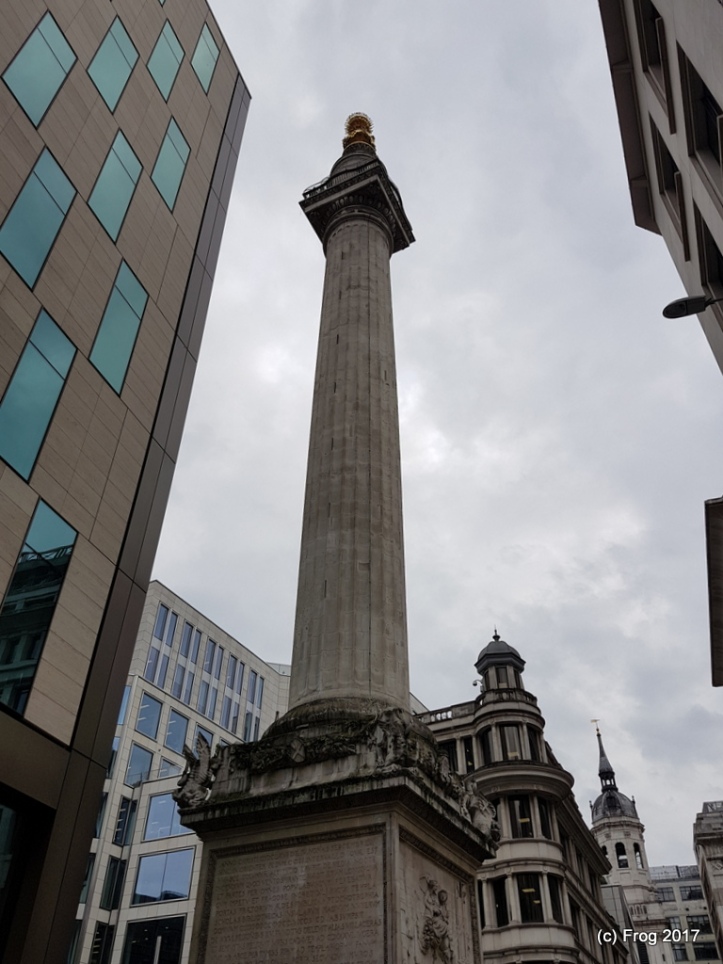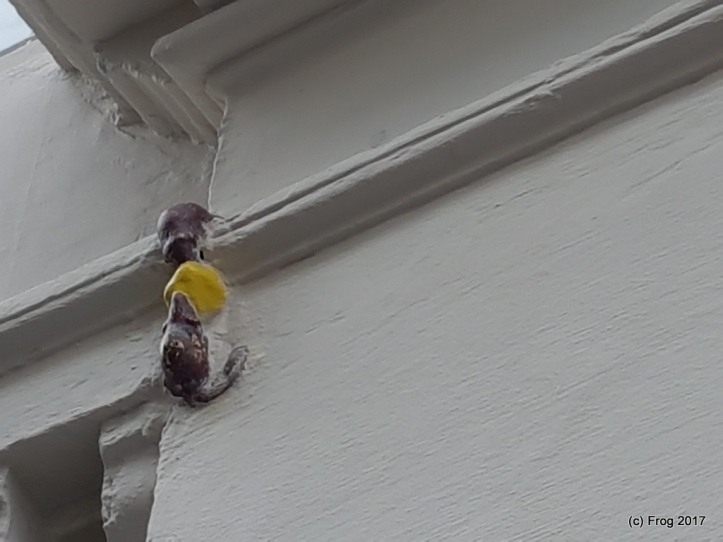It’s been a little while since I had a fun walk – but this was a little more joggy than walky, but still do-able if you’re up for it.

I started at Monument station, which is (if you didn’t know) there to “celebrate” the Great Fire of London. If it falls, it is said that it would land right at Pudding Lane, where the fire started – but to be honest if it was to fall now it would most likely lean against the many buildings that surround it. Growing up this was something that towered over the buildings – now, you can see it if you know when to look. There are steps up the centre – I’ve never been and with the view non-existent now I doubt I will. Anyway, that’s not why I started here – I wanted to find the smallest public sculpture in London. And there’s a link to the column too.

Just around the corner on the junction on Philpot Lane and Eastcheap, next to the “Walk Talky Tower” up on the wall is the art. Two mice, fighting over a piece of cheese. Do you see it?

It’s a shame the painters weren’t careful, but this is a “blink and you’ll miss it” affair. Now, the story I heard about this was in regard to the monument. Two of the builders were sitting on the column having lunch, when one noticed his sandwich had been nearly eaten. He accused his friend and they had a scuffle – unfortunately they fell off the column and being a fair way up didn’t survive. But shortly after that, it was discovered that mice had infested the column. (I’ll be honest here, I got the story from: https://blackcablondon.net/2012/04/29/cabbies-curios-londons-smallest-statue/)
So, having found the mice, it was time to find something that would link these things together. I jogged up Eastcheap and onto Cannon Street – as I passed the Cannick Tapps (a small bar that is underground) I did wonder if it was worth just turning the whole thing into a wibbly walk; especially as this part of town is very bar heavy.
At the end of Cannon Street is St Paul’s Cathedral, but next to it is Paternoster Square. The entrance to this space is an archway (Temple Bar) that was also designed by Wren and was originally in place on Fleet Street to mark the western end of the city’s influence. It was moved in 2004 from its previous location at a cost of £3million!
After St Pauls is Ludgate Circus and then Fleet Street, which was at one time the home of all London newspapers (and a reason for many of the bars I’m sure). But one has stood the test of time, Ye Olde Cheshire Cheese.
This was rebuilt in 1867, but inside it still has the Old World charm, plenty of little booths where journalists and editors could still and get news stories. And just round the corner from here is Dr Samuel Johnson’s House (Dr Johnson wrote ‘A dictionary of the English Language’ in 1755… considered to be the first English Dictionary.) But literary reasons aside, it was my next statue I was after… Hodge.
Hodge was one of Johnson’s cats and was identified only in one book, James Boswells ‘The Life of Samuel Johnson’ (pub. 1791) and considered to be one of the top books in the biographical genre.
So with mice, cats and cheese now under my belt (so to speak), I continued onwards. I’d been asked to get a few pictures of Balzagette’s bust, so I headed off to do that along the Embankment (I’m sure I’ve mentioned it before, but in case… he created the sewer system that lies beneath London. In particular he also considered the growth of the city and what size pipes would be needed – interestingly it is unlikely he would have ever considered the tower blocks of today, but even now the system is still coping with the additional people in the city and some is still original. The system was in response to what was called “The Great Stink” during the summer months in 1858 and changed from the existing practice of dumping the sewage straight into the Thames.
Of the pictures above, you get an idea of the width of the Embankment when you consider that Somerset House used to be right on the edge of the Thames. The street furniture of Egyptian motifs and the fish were winners from a competition rather than any particular reason. But the Lion heads ARE important. It is said that if those rings dip beneath the river, then London will flood. So if you’re walking past them, have a look!
From the Embankment I headed up Northumberland Avenue. Originally this was were the Duke of Northumberland had his mansion, it was redeveloped with the express intention that hotels would be built here for visitors and tourists – and this is why the road is so wide compared to other London roads. At the top end of this is probably one of the most famous London Landmarks, Trafalgar Square.

Although well known since the 13th century, it wasn’t until around the 1840s when it actually became the square as we know it. What I didn’t realise was that the fourth plinth has been empty all that time (until 1999 when it became a location for modern art installations). But inkeeping with story of this walk – it’s the lions that are interesting here, especially their paws.
The sculptor Landseer asked London Zoo if he could have a dead Lion brought to his studio so that he could model one. Unfortunately, the lion decomposed and so the paws were modeled on a cat’s paws! I suspect that it was his source material that is the other point that is often made about the lions – when in this position their backs are usually convex, not concave. But hey, with the amount of people climbing over them, I doubt they’ve noticed. But don’t think you can just take one home either – each lion weighs seven tons!
So that was my wibbly walk. Well, almost. You see, there was one more piece of art I wanted to find. I have a “nose” for it you might say. Under one of the arches of Admiralty Arch is a nose.
Whilst there have been many reasons for this – such as a spare nose should Nelson’s fall off – the truth is that in 1997 the artist Rick Buckley set out and installed 35 noses around London. But he stayed quiet about it until 2011 and many were removed – but there are still some around London (this link offers a guide to finding them: http://www.london-walking-tours.co.uk/the-seven-noses-of-soho.htm )
What I will say is that this one is REALLY difficult to get to as the arch is used by traffic. Fortunately the lights were red and so I could cross to get it – much to the confusion of the taxi driver I was standing next to as I took the pictures! He hadn’t seen that before, so I was pleased to be able to tell him about something London he didn’t know!
References:
With the exception of the two links in the article, all other dates and references came from Wikipedia.



















Love this!! I guess I’ll be tracing your steps for this one! Quite interesting David!
Good stuff!